Exhibition catalogue accompanying our exhibition Amongst The Trees. The exhibition is on display in The Gallery June-July 2024. Amongst the Trees is a celebration of creativity and the diverse ways in which artists engage with their natural and man-made surroundings.
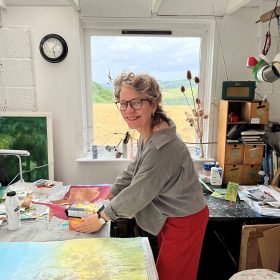
My attention is invariably drawn to the wild banks and untouched woods and field margins, with their abundance of flora and fauna, observing their transformations through the seasons. I focus on the small elements which make up the bigger picture. I seek to highlight and celebrate the beauty of the seemingly inconsequential.
Sheila Anderson-Hardy studied at The Glasgow School of Art in the late 70s under Alexandra Gardener and James Cosgrove. She is now a full time painter based in the Scottish Borders. She combines Sumi-e ink washes, watercolour and collage to depicts landscape, verges and hedgerows and her encounters with the wildlife that inhabit these spaces. Her work is densely layers and delicately drawn. As well as several successful solo and group exhibitions her work is regularly selected for prestigious national open exhibitions. She was elected as a member of the Royal Scottish Society of Painters in Watercolour in 2024.

Ash & Plumb was created by design duo Barnaby Ash and Dru Plumb, born of a desire to honour naturally sustainable materials; crafting unique and functional works that breathe life into the living spaces they inhabit.
‘In an increasingly mass-produced culture, we have decided to walk a different path; paying tribute to traditional craft in a modern context we realise classically formed pieces that allow the natural beauty of the material to shine. We consider ourselves editors not creators of nature’s finest work. For this new collection, we wanted to symbolise the strength that comes with a diverse and physically connected community; communities that we have all been so starved of in recent times and yet are so essential to our sense of belonging and support systems. Each piece we have created is unique in character and form whilst bearing a familial aesthetic that brings them together, celebrating the magnificent diversity within our native hardwoods that mirrors that of our own human counterparts.’ – Ash & Plumb
Ash & Plumb present their second solo exhibition with The Gallery in June-July 2024 – Echoes.
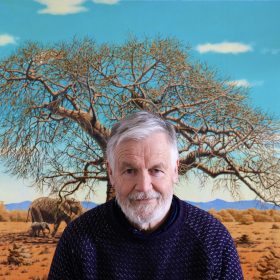
Reinhard Behrens was born in Germany 1951 and studied Drawing and Painting from 1971-78 at Hamburg College of Art. In 1979 he was awarded an academic exchange grant which allowed him to complete a Postgraduate Course in Drawing and Painting at Edinburgh College of Art. Between 1982 and 1986 Behrens worked as a part time lecturer at Edinburgh College of art, the Glasgow School of Art and Grays School of Art in Aberdeen.
Behrens’s practice inhabits a fictional world called Naboland, a mythical place of snow and ice. For over forty years, the artist has examined this world through the lens of a real history of discovery, with the artist adopting the role as explorer to create an archive of drawings, paintings, prints and installations which record the found objects and landscapes of Naboland. 2025 will mark the 50th anniversary of Naboland.
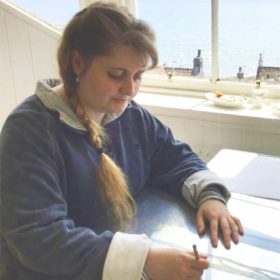
Kirstie Behrens is an award-winning artist and printmaker, based in Pittenweem in Fife. She graduated from Duncan of Jordanstone College of Art and Design in 2019 and in 2021 she won the Roy Wood Prize for Printmaking, the Art in Healthcare Award and the W Gordon Smith & Jay Gordon Smith Award from the Royal Scottish Academy. Behrens practice revolves around time-based projects where natural elements are actively incorporated as tools in her practice, creating marks which leave traces of evidence of the passage of time. Traditional etching is a printmaking technique that involves using acid to bite into a metal plate (usually copper, zinc, or steel) to create an image. Using a sharp etching needle or other pointed tool, Behrens then draws directly onto the surface of the plate, exposing the metal beneath the ground. The lines and marks will later be etched into the plate. Traditional etching allows for a wide range of mark-making and tonal effects, making it a versatile and expressive medium for artists. While the process can be time-consuming and requires careful handling of hazardous materials, it offers unique opportunities for artistic experimentation and exploration. Behrens will be the subject of a solo exhibition in 2025 alongside her family, who are all practicing artists

I hope that my paintings elicit curiosity, allowing the viewer to fill them with their own narratives, with their own memories real or imagined, like fairy tales. My aim is to try to evoke that moment of anticipation in a theatre, when the curtain lifts on the stage and reality is suspended.
Margaret Smyth (Behrens) graduated from Edinburgh College of Art in 1983. She is a regular exhibitor at the Royal Scottish Academy, Society of Scottish Artists and the Royal Society of Scottish Painters in Watercolour. Margaret is married to fellow artist Reinhard Behrens and they are parents to Kirstie Behrens and David Behrens. Margaret will be the subject of a solo exhibition at The Gallery alongside her artist family in 2025.

‘I work with both paint and clay to make multidimensional imagery which reflects on the global, transcultural nature of myths and ceramic archetypes.’ Stephen Bird
Stephen Bird was born in Stoke-on-Trent in 1964 and has lived in Australia since 1999 after graduating from Duncan of Jordanstone College of Art in Dundee. Making his home and a significant international reputation from New South Wales, Australia, he works with both paint and clay. His work is exhibited both nationally and internationally and he has won both The Gold Coast International Ceramic Award and the Deacon University Small Sculpture Award. His use of words, collage and found objects as part of the final work, results in powerful multi-dimensional imagery which reflect on the global, transcultural nature of myths and ceramic archetypes.
I believe visual art is all about humanity’s relationship to objects and I wish above all to invoke the emotional connections which are felt towards things that have been made by hand with love. I create narratives which explore hybrid identities and transgressive themes such as taboos, cruelty, war, natural disasters, unnatural affections and violent deaths. My works are located in the extremes of the tragicomic tradition. I reinterpret old stories both remembered and imagined and appropriate iconography from established pottery traditions; a decorative Royal Doulton tile, or the cabbage leaf from a Wedgwood Whieldon teapot. I am particularly interested in Staffordshire ceramic figure groups from the 18th century which contain implicit meanings and I often try to decipher their hidden meanings and reimagine these in explicit ways. Stephen Bird
Public collections include:
National Gallery of Australia, Canberra; Art Gallery of South Australia, Adelaide; National Museums Scotland, Edinburgh; National Museums Northern Ireland; The McManus Art Gallery & Museum, Dundee

A graduate of Duncan of Jordanstone College of Art and Design, Philip Braham first came to prominence in the 1980s with the rise of figurative painting in Scotland, which culminated in The Vigorous Imagination, an exhibition at the Scottish National Gallery of Modern Art in 1987. His career includes 27 solo exhibitions to date; in addition to numerous group shows both nationally and internationally. Among the awards received are the prestigious Royal Scottish Academy Guthrie Award for painting and the Royal Scottish Academy Morton Award for lens-based work. Recent exhibitions include solo shows at Perth Museum and Art Gallery, The Scottish Gallery and at the Royal Scottish Academy. A longstanding interest in continental aesthetics informs his pedagogical role as Senior Lecturer in Contemporary Art Practice at the University of Dundee. He was elected to the Royal Scottish Academy in 2021.
Braham’s paintings are informed by the Northern European engagement with landscape as a metaphor for the human condition. Recent projects reflect on the temporal nature of our existence through personal recollection and collective history, set within the slowly evolving landscape that bears us forward. Fidelity to experience is fundamental to his practice, and this brings a poetic grace to his technical mastery of oil painting.
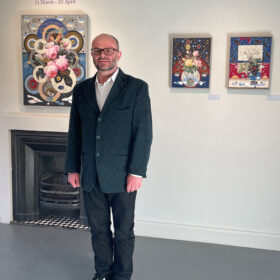
‘The essence of these works is setting up a direct conversation with an artist from a different age. Traces of humankind float through these images of nature.’ Colin Brown
Colin Brown is a fine artist and former graduate of Duncan of Jordanstone, Dundee. After graduating, a John Kinross Scholarship awarded by the Royal Scottish Academy enabled him to spend four months in Florence. In 1988 he established a studio in Glasgow, where he began practicing as a full-time artist. He also spent four years in Dusseldorf painting and exhibiting with several German galleries. He is now based in Stonehaven in northeast Scotland.
Colin Brown’s practice draws upon a range of media, particularly acrylic paint and collage. His work draws upon human histories, random and specific mark-making, urban imagery, and a mix of handwriting and printed script to explore the spirit of modern society. Brown has developed a strong international profile with regular solo and group exhibitions worldwide, including major solo shows in Hanover (1998), London (2010) and Singapore (2013). His work has received a number of awards, most notably an Artists Grant from the Pollock-Krasner Foundation, New York in 1996.

Doug Cocker was brought up in rural Perthshire and comes from a long line of farmers and blacksmiths. He taught sculpture at Nene College, Northampton and Gray’s School of Art, Aberdeen and over a period of twenty years he was visiting lecturer at Edinburgh University, Edinburgh College of Art, The Glasgow School of Art, Duncan of Jordanstone College of Art, Dundee, Tyler University, Philadelphia, Georgian College, Ontario and Newcastle Polytechnic from 1992–1998. He was elected to the Royal Scottish Academy in 1984. Cocker has undertaken many public sculpture commissions including the Ben Lomond Memorial at Rowardennan and the Glasgow Bouquet in the Merchant City, Glasgow. Doug Cocker’s sculpture is the artist’s response to the landscape and natural environment around him. Working predominately in wood, his studio in Lundie, outside Dundee, is a magnificent thinking space where the walls are littered with evolving ideas.
Public commissions include:
Perth, Glasgow, Dundee, Ayr, Oldbury, Cardiff, Bristol
Public collections include:
Aberdeen Art Gallery; Arts Council Collection, Southbank Centre; The McManus: Dundee’s Art Gallery and Museum; City Art Centre, Edinburgh; Kelvingrove Art Gallery and Museum, Glasgow; Hunterian Art Gallery, Glasgow; Greenshields Foundation, Montreal; Peterborough Art Gallery; Royal Scottish Academy of Art and Architecture, Edinburgh; Northampton Art Gallery; Kirkcaldy Galleries; Perth Museum and Art Gallery; The Ballinglen Archive, County Mayo; Robert Gordon University Collection, Aberdeen; University of Dundee; Boswell Collection, University of St. Andrews; Arts Council of Great Britain; Old Hawkhill, City of Dundee, Dundee; University of Stirling; Hospitalfield, Arbroath; University of South Wales Art Collection Museum
Doug Cocker will be the subject of a major new exhibition Threads this May at Dovecot Studios. The exhibition, which is in collaboration with The Scottish Gallery and Dovecot Studios, will run from 24 May – 19 July 2025. Please contact The Gallery for more information.

Born in North Carolina, Kate Downie studied at Grays School of Art in Aberdeen before travel and residencies took her to the United States, England, Amsterdam and Paris. Over the past two decades Downie has established herself as one of Scotland’s most prominent artists. Her skill not restricted to painting alone, she works across a diverse range of artistic medium. One recent project for Pittenweem Arts Festival saw Kate juxtapose large colour-field prints with architectural charcoal drawings with extraordinary results. The majority of her work is defined by geography, and the artist’s response to the landscape or subject in front of her. Kate’s constant search for new challenges and inspirations has seen her set up studios in such diverse places as a brewery, an oil rig, and for her most recent show an abandoned Hydroponicum. Her work is held in many public collections including Glasgow Gallery of Modern Art; Kelvingrove, Art Gallery: Reitveld Kunst Academie, Amsterdam; the BBC and Edinburgh Council. Downie has enjoyed ten solo exhibitions at The Scottish Gallery. She is currently exhibiting at the Glasgow Women’s Library with Conversations with Joan. An exhibition based around Downie’s creative journey to complete a version of Joan Eardley’s painting Two Children left unfinished on her Townhead Studio easel at the time of her death in 1963.
‘One of my creative concerns is to define these spaces between buildings rather than the buildings themselves. The object lesson for me is the witnessing and the drawing of these nonplaces which are also, by definition, public arenas of cumulative activity. My job as an artist is to accommodate these actions in our contemporary lives, and to find the poetry within.’
– Kate Downie

Edinburgh based artist Andrea Geile studied Visual Art in Hanover, Germany, and has held residencies in Orkney, Germany, France and Australia. She has been working from her Scottish studio since 1996 and has realised many public and private art commissions. Her outdoor sculptures are made from Corten steel, often grouped with real plants and relating directly to the site environment. They are subtle interventions, merging into the landscape and are often only visible on closer inspection. Among others she has received Awards from the RSA and the RHS Chelsea Flower Show.
Andrea’s sculptures are hand-made from Corten steel; a weatherproof steel that forms a protective layer which stops further corrosion. They therefore have an unlimited life span and do not stain. Andrea fabricates all her sculptures herself. The patterns are first drawn onto sheet metal then hand-cut, assembled like a 3D puzzle and finally welded together. Andrea has worked on several large scale public commissions including Culzean Castle and, most recently, a sculpture commission titled ‘The Chlorophylles’ at the FANK Arts & Heritage site in Lettermore Forest on the Isle of Mull; celebrating the community effort bringing this site back to life.
Public Collections include:
City of Edinburgh Council; The University of Edinburgh; NHS Tayside; City of Albany Art Collection, Australia

Martin Greenland was born in Yorkshire and studied at Exeter College of Art. He has lived and worked in Cumbria since 1985. In 2006, Greenland was awarded first prize at the prestigious John Moores Painting Prize, the UK’s largest contemporary painting exhibition held at the Walker Art Gallery, Liverpool. Martin Greenland is primarily a realist painter; his subject is embedded in the North British Landscape, at first familiar yet entirely imagined – in Greenland’s work, a subtle narrative about contemporary Britain quietly emerges.
I rarely come to start any work with the structure or concept fully formed. My paintings can best be described as improvisations. Sometimes strong images which exist somewhere in my head at the beginning form the resulting work. More often these starting forms radically change; the painting finding its own course. This is when I can describe painting itself and watching the landscape come into being and evolving , as exploring , going into new territory. I often find the reason for the painting or its concept, as I am part or often well on the way through. Very often I begin paintings with just pure paint, pretty abstract. I put paint down in fairly spontaneous ways to give me the unexpected which is always there ‘in nature’.

Born in 1963 in Perth, Scotland, Derrick Guild has been the recipient of many awards for his unique work. Guild’s paintings and objects reference European still life of the 15th to 19th centuries. The drama, allegory and naturalism inherent in this period of painting speak to Guild of ever-present dilemmas of the human condition. His works are classical, formal and at the same time contemporary in their sense of dislocation and ambiguity.
‘In my work I am trying to create fluidity between the past and present. I make still life paintings using oil on canvas and objects that use a wide range of materials including cast resin, oil paint and miscellaneous materials. In the paintings, I am trying to harness the look and feel of the great European still life tradition. I want to hijack the high drama and emotional integrity that resonates in the work of that era. I aim to marry that look and feel to contemporary ideas and thoughts that include religion, colonialism, genetic modification, sexuality, commodification of nature, fecundity, humour, appropriation, addiction, beauty, absurdity, surrealism and realism. This list is always growing and is never closed. I feel the still life format easily allows narrative and metaphor, complexity and simplicity to be conveyed. Whilst every painting can be read alone, I feel that they are each a single sentence in a much longer and ongoing dialogue. The objects are in a sense three-dimensional versions of my still life paintings. They have developed from the realisation that an object resonates differently when it interacts in a space as a real object. I am trying for a more heightened sense of realism so that the experience of the object is not filtered through the two-dimensional canvas.’ – Derrick Guild

Lord Haig, son of the Field Marshall, was a prisoner of war in Colditz Castle until his release at the end of the War. The paintings and drawings he made there were exhibited at The Scottish Gallery and he went on to have a distinguished exhibiting career which spanned over 60 years, concluding with his remarkable 90th birthday show in 2008. This must be one of the most consistent relationships between an artist and a gallery in the annals of the commercial art world.
In June 2011 we hosted a memorial show and in March 2018 a major centenary exhibition. The show included work from every decade of his distinguished career post war, and demonstrated his astonishing talent in landscape and subject painting.

Claire Harkess was born in Ayr, Scotland, graduating from Glasgow School of Art in the early 1990s. In recent years her painting has taken her to fragile lands to study and interpret life on the edge. Antarctica, Outback Australia and St Kilda are all places where, in such extreme environments, survival is difficult and the balance of life is delicate. Six hundred miles due west of Ecuador surrounded by the Pacific Ocean lie the Galápagos Islands, made famous by Charles Darwin’s ‘The Origin of the Species’. This isolated volcanic outpost remained relatively untouched by man, evolving to become one of the World’s unique ecosystems. The balance present in nature is clearly communicated through the paintings. Painting in watercolour offers a unique directness; the essential qualities of light and energy present in the natural world are the very essence of the medium itself. The delicacy of her palette and oriental economy of her mark-making creates a subtle tension representing a world that is ‘holding still’, giving a sense of freedom, spirit, time and place.
Claire exhibited at The Scottish Gallery in April 2018, exploring the idea of A Wilder Place. In July 2020 Claire presented an exhibition Into the Wild, featuring works created in the Arctic Circle and rewilding centres in Scotland. In March 2022 Claire’s exhibition The Garden, opened in The Gallery. The exhibition explored her immediate surroundings in Perth from a collection of borrowed gardens. Claire carefully and joyfully captured the visitors: the birds, the squirrels, the badger, and for the first time she brought the flora to the foreground while a butterfly or a tiny snail might be found in the detail. This close-up of the familiar natural world, so easily overlooked, has expanded her practice. Her work has a delicate, oriental sensibility, suiting longer formats, and employing kintsugi techniques, adding to their sense of fragility.
‘I return again and again to wildlife and the natural world. It surprises and inspires. No two encounters are the same. Being present in something greater gives perspective. There is always something new to learn. It is an anchor that holds all of us and it must be protected.’ – Claire Harkess

My studio practice originates, not from an idea, but an imaginative engagement with reality. The paper-cut collages and paintings, selected from a current body of works, exhibit the characteristics and the trajectory of an evolving artistic production. At the moment of assembly, paper-cut collages give shape to and advance the corresponding paintings and small sculptures. To the classical principles and conventions that continue to inform my studio practice, one can add abstraction or, to be precise — abstracting from. This method of construction initiates new opportunities in the representation of the motif in both shape and colour.
Euan Heng was born in Oban in 1945 and moved with his family to Australia in 1977. He lives and works in Melbourne. Between 1960 and 1970 Euan was employed in various occupations, including four years as a merchant seaman travelling worldwide. He completed undergraduate and postgraduate studies at Duncan of Jordanstone College of Art & Design, Dundee in 1975 and was awarded a research MA from the Royal Melbourne Institute of Technology University in 1995.
Euan Heng explores the role of abstraction in figuration through his practice. Much of his work derives from something seen, heard or remembered, but Heng also plays with artifice and the imaginary. His fascination with flatness, expressed with immediacy and economy is influenced by his interest in Italian iconography, medieval frescoes, Chinese portraits and 16th century Mughal art. His elegant meditations on line and shape incorporate recurring motifs from the artist’s career, including the portrait, stripped of many features; the tree, sharp and geometric; and the sea, which figured so strongly in the artist’s early life as a sailor. Heng has exhibited extensively in Australia and abroad and his work is represented in major public and university museum collections in all states of Australia and in Scotland.
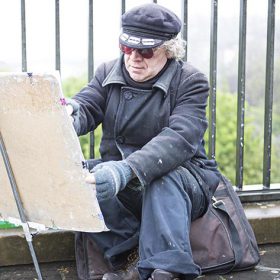
Michael McVeigh was born in 1957 in the post-war council estate of Lochee, Dundee located on the north west of the city, one of five children. He left school with no formal qualifications; however he wanted to be an artist and so began, unannounced, going to classes at Duncan of Jordanstone College of Art & Design, his presence being challenged eventually. James Morrison, then one of the lecturers, formalised his position and accepted him as a full-time student based only on his outstanding drawings and painting.
Since moving to Edinburgh in 1982 McVeigh became a familiar figure seen regularly working in the city and until a few years ago as a street artist. Life as a street artist brought a certain amount of unwanted celebrity status, especially in recent years, becoming a cult figure sought out by the city’s stag and hen parties, eventually having to limit tourists to ‘one photo only’.
Michael McVeigh is a modern day folk artist who depicts the world around him. He is a participant observer who has created a naïve and sophisticated setting for contemporary life and history. There is something of the medieval chronicler about him; he draws and paints what is there, and what is worth depicting because it is an essential, occasionally quirky, part of human existence.
His works are held in both public and private collections including town halls, pubs, fishmongers and a number of municipal and national institutions.

James Morrison sadly passed away in 2020. He was a great painter and a huge part of The Scottish Gallery for more than sixty years, the last thirty under an exclusive arrangement. His kindness, generosity and loyalty made him a hugely rewarding friend, and it has been a privilege to represent one of Scotland’s most distinctive and brilliant painters.
Born in Glasgow in 1932, Morrison studied at Glasgow School of Art from 1950-4. After a brief spell in Catterline in the early 1960s, Morrison settled in Montrose in 1965, joining the staff of Duncan of Jordanstone College of Art in Dundee the same year. He resigned from Duncan of Jordanstone in 1987 to paint full-time and since then his work has been exclusively available through The Scottish Gallery. Whole-heartedly a landscape painter, his main working areas are the lush, highly-managed farmland around his home in Angus and the rugged wildness of west coast Assynt. As well as Scotland, Morrison has had extended painting trips to Africa, France, and Canada, including three trips to the Arctic in the 1990s. A suite of his Arctic paintings were acquired and exhibited as part of a major exhibition, Among the Polar Ice at The McManus in Dundee (September 2019 – March 2020).
James Morrison first exhibited with The Gallery in the fifties, and over the course of his career, he enjoyed over twenty-five solo exhibitions with The Gallery, which also organised several one man shows elsewhere in the UK and internationally. In June 2022, The Scottish Gallery celebrated the life and work of one of Scotland’s most-loved artists in a major retrospective show James Morrison A Celebration 1932 – 2020. The exhibition, held two years after his death, presented work from the entirety of his artistic career which spanned seven decades.
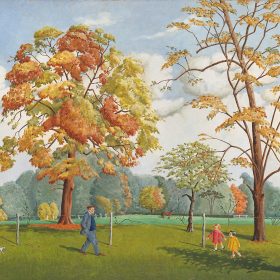
Ula Paine was a painter of rare talents and originality whose work remains largely in the dark. Her early precocity was nurtured within a liberated, artistic household: her grandfather was the Victorian painter George Hilditch, but art school and the hard realities of professional necessity crushed her vitality and she had to wait until after the War for her métier to be allowed to flourish. London’s leafy suburbs and parks, its quiet corners, gardens and canals, peopled by a reemergent middleclass gave her her subject and a pitch perfect atmosphere of ‘other’. The optimism of The Festival of Britain in 1951, the expansion of art publishing, magazines, the homemaking impulse, aspirational interior design, television and advertising all created a milieu in which her beautifully composed urban landscape and poised, enigmatic still life found their place. For Paine, trees are as much the landmarks of the urban as the architecture; trees judiciously planted, listed and looked after made a resurgent London a place of calm, as much survivors of The Blitz as the people walking their dogs and wheeling their kids in prams in the sunshine and shade. She lived a long and productive life and her show at London’s Grosvenor Gallery in 1991 at eightyone earned her an interview with Micheal Parkinson: a character; feisty, a survivor. But we must look at Paine’s work to recognise her talent. Guy Peploe

David Rae, like any good modernist, will not provide a key to interpret his work. He chooses a subject which can be described as landscape, but which owes as much to Magritte as to Claude or Constable.
Raised in southwest Scotland, David Rae studied Painting at Grays School of Art in Aberdeen from 2013 and 2017. Following his degree show he was selected for the 2018 Royal Scottish Academies New Contemporaries where he won both the Walter Scott and the David and June Gordon memorial trust awards. In 2024 he was shortlisted for the Gilchrist Fisher Award for artists exploring the theme of landscape.

Paul’s ongoing body of mythologically inspired paintings have worked so well because of his powers to instil a potent sense of reality. It is not an arcane or unreachable reality but something timeless and tangible. Characteristic of his subsequent works is his ability to impart a vast amount of information without confusing or distracting the viewer. His paintings overflow with visual material: images of fruit and vegetables, costume, portraiture, human form in action, metamorphosis, landscape, architectural details and still life. All of these elements play a part in his highly orchestrated compositions. Derrick Guild
Paul Reid graduated from Duncan of Jordanstone College of Art in 1998 after which he was awarded a Carnegie Trust Vacation Scholarship and a John Kinross Scholarship. In 2004, he accompanied HRH The Prince of Wales on a trip to Turkey and Jordan, completing a series of paintings and drawings based on the landscape and people they visited; a further visit to Canada with HRH followed in 2009. Paul Reid has immersed himself in the techniques of the Renaissance masters and has found his subjects in the potent imagery of the Greek Myths as recorded in Ovid. He has exhibited with The Scottish Gallery since 2002, enjoying six solo exhibitions. His work is held in the collection of Perth Museum and Art Gallery, The Fleming Collection and the universities of Dundee and Aberdeen.

I am always moved when painting in nature because wherever I look I feel hope – the skylarks singing high in the sky despite the stormy weather and the light sparkling like gold dust on the shoreline. I carry my art materials in my trusty trolley, weathered by big hills, rocks, sand and even snow. It keeps all my materials together in one place and saves my back from a heavy rucksack.
Pascale Rentsch is an award winning Swiss-born artist living in East Lothian, Scotland, where she makes the most of her surrounding countryside, hills and coastlines. She draws and paints plein-air, directly from nature in all conditions.

Bruce Thomson – or ‘Adam B’, as he was often called – was a painter of great integrity whose long, productive life tells the story of Scottish painting for the first three quarters the twentieth century. Thomson was born in 1885, attending first the Trustees Academy and then the newly established Edinburgh College of Art where he received diplomas in both Drawing and Painting, and Architecture before scholarships took him abroad to Spain and then Paris. He was an accomplished etcher and lithographer and he also sought expertise in the difficult media of pastel and watercolour. By the 1920s, his technique was closest to S.J. Peploe, Cadell and other contemporaries favouring the technique of painting on a gesso ground with an oil-reduced vehicle so the subjects tended to be treated in flat areas of colour.
Thomson served in the Great War before returning to the College where he taught etching, composition and still life to the painting school and colour theory to the architecture students. His association with Edinburgh College of Art continued until his death as, although he retired from teaching in 1950, he continued as an examiner and a Trustee. His links with both the RSA, where he was Treasurer for seven years and the RSW, where he served as President for a further seven years from 1957 were very important to him. He was awarded an OBE in 1963. In 2024 the City Art Centre in Edinburgh is holding a major retrospective of his work, The Quiet Path, his first major exhibition in a public institution, to coincide The Gallery will honour Thomson with an exhibition in September 2024.